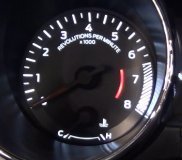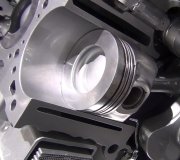You torqued the nuts in the center of the rocker arms? Those are adjustments, not nuts to be tightened. They are lock nuts so they are going to have some resistance to being turned which may have given the illusion they were being torqued.
Chrysler's push rod engines use lifters that have a lot of travel to accommodate the expansion of the push rods. GM's lifters do not have that much travel, so the rocker arms need to be adjusted to center the plungers within the lifter bodies. There is a procedure that involves setting the clearance between the tip of the rocker arm and the tip of the valve stem, then you tighten the nut a specified additional amount, but that is very time-consuming and not very precise. It requires rotating the crankshaft, by hand, to various positions, then the listed valves are adjusted at each position.
A faster method is to back off the nuts enough so the valves can fully close, then run the engine while making the adjustments. Ideally the engine will be warmed up when doing this. GM gets oil to the rocker arm tips through hollow push rods and holes on the rocker arms. That makes the oil splatter out of the engine where it makes a mess. Fashion shields out of cardboard and lay them on the outer edge of the heads so the oil lands on them and runs back into the engine. The cardboard new valve cover gaskets come on makes nice shields.
If the rocker arms are excessively loose, run the nuts tighter until the clattering stops. Pick the first valve to adjust. Tighten the nut just until the engine starts to misfire. Remember that spot. That is where the lifter is still fully-extended. The misfire will go away within a few seconds. Now tighten the nut 1/4 turn, then wait a few seconds for the lifter to bleed down and the misfire goes away. Let it idle there for perhaps ten to fifteen seconds, especially for exhaust valves. They need to close fully to have time for the heat to transfer to the valve seat so the valve head does not overheat and start to burn away. Tighten the nut another 1/4 turn, then wait again for the misfire to go away. Each time you tighten the nut, the valve will be held open until the lifter bleeds down. A fully-pumped-up lifter can take twenty seconds to bleed down. You are only making it bleed down a small amount each time you tighten the nut.
Keep track of how many turns you tighten the nut. After roughly two to maybe three full turns, you will reach the point where the lifter is fully-collapsed and the valve is being held open. The misfire will not go away. Now loosen the nut just until the misfire stops. This is the ending point where the lifter is at its other extreme. Back the nut off half the number of turns from the starting point.
A typical adjustment I have found is 2 1/2 turns between fully-extended and fully-collapsed. From fully-collapsed, back the nut off 1 1/4 turns. That will put the lifter's plunger right in the middle of its travel. That gives it enough room to adjust for really cold and really hot push rods.
Sunday, February 11th, 2018 AT 10:12 PM


